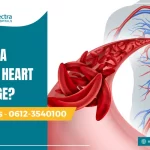Heart attacks perhaps rank among the most dangerous medical emergencies caused due to lack of normal blood flow to the heart. Blockages in coronary arteries due to plaque buildup is mostly to blame for it.
Moreover, when we think of heart attacks, we usually envision intense chest pain and dramatic symptoms. However, real-world experiences show a more complex range of symptoms, which are especially diverse for women.
Usual understanding of heart attack symptoms is very much based on male experiences. This can eventually result in a big knowledge gap that can endanger women’s health.
The heart attack symptoms in women can be subtle and distinct from the typical male symptoms. Men typically experience severe chest pain in a localized area while women often have a combination of multiple and less susceptible signs.
Most women may not suspect any illness and may not even seek medical help. Thus, the significant differences between male and female heart attack symptoms can also cause delayed treatment, increasing the danger of serious heart problems and life-threatening situations.
Why are Heart Attack Symptoms Different in Women? Causes Explained
It’s common for female heart attack patients to mention symptoms that may not appear connected to heart problems.
Signs of heart attacks in women may manifest as unexpected fatigue as well as indigestion and shortness of breath. A heart specialist in Patna would attest that these symptoms are frequently overlooked or misinterpreted, resulting in dangerous treatment delays.
6 Key Reasons for Symptom Variations Among Females
Some of the common reasons why women may experience heart attack symptoms differently are mentioned below.
The most obvious reason according to the medical practitioners is the hormonal differences. Let’s go through each of the causes behind why women’s heart attack symptoms are different than men’s.
1. Biological Differences in Cardiac Structure
The heart and blood vessels of women have structural differences when compared to those of men. The female heart is generally smaller and has thinner vessel walls along with different muscular compositions.
These structural distinctions between male and female cardiovascular systems cause disruptions in blood flow and arterial blockages to present in unique ways which lead to complex symptom patterns that often differ from classic heart attack signs.
Interestingly, gender differences also lead to substantial variations in both the size and elasticity of blood vessels. Women’s arteries have greater sensitivity to hormonal fluctuations, which impacts the way they experience cardiac stress.
All these differences in a woman’s biological factors result in them not showing the classic crushing chest pain during heart attacks, which is very typical for men.
2. Presence of Microvascular Disease
This small blood vessel disease occurs more frequently among women. Microvascular problems can cause unpredictable cardiac stress compared to the dramatic symptoms large vessel blockages produce. Women affected by this condition, as a result, experience various unconnected symptoms instead of the localized chest pain.
Doctors must work harder to diagnose heart issues in women because these microscopic vessel changes happen even when large arteries seem clear.
The impact is understated yet substantial as it can lead to persistent inflammation and decreased circulation which slowly harms heart tissue.
3. Hormonal Factors
The female hormone, estrogen, maintains cardiovascular health, and its levels can cause significant changes to heart function.
Inflammation levels undergo changes throughout various life stages including menstruation, pregnancy, and menopause. This mainly happens due to hormonal fluctuations.
The changing hormonal levels in women can cause distinctive symptoms in heart-related events. The protective cardiovascular benefits of estrogen reduces during menopause, which naturally elevates the risk of heart disease in females.
Thus, the intricate relationship between hormonal activity and heart health in women creates more unpredictable cardiac symptoms for them.
4. Psychological Factors
The distinctive psychological and neurological mechanisms in women cause them to experience stress and physical discomfort differently. The presence of depression and anxiety can, in fact, obscure heart attack symptoms, which complicates self realization of symptoms for females.
Women also tend to interpret that symptoms are being caused by stress or minor health problems instead of recognizing them as serious conditions.
Furthermore, delayed symptom recognition and treatment can even result from the psychological factors affecting their symptom perception. The ways women understand and manage physical discomfort are often influenced by social norms, which may cause them to overlook critical signs of heart issues.
5. Variation in Plaque Buildup
Gender differences exist in arterial plaque accumulation patterns, thus resulting in symptomatic differences between men and women. Men develop concentrated and hard plaque formations compared to women who tend to show diffuse and softer plaque build ups.
The difference in plaque characteristics between men and women is an important factor. Blockages in women develop slowly with less severe immediate effects which results in less noticeable symptoms.
For this reason, traditional diagnostic procedures exhibit increased difficulty when identifying plaque variations.
Standard diagnostic tests may fail to detect soft and dispersed plaque formations, which means health professionals need to use advanced imaging techniques to assess cardiac risk in women.
6. Delay in Seeking Treatment
Women often seek medical attention based on their cultural background and personal beliefs.
Most women often dismiss their medical symptoms and choose to put caregiving responsibilities above their own health while crediting their physical discomfort to stress or age. The risk of suffering a heart attack can be substantially affected by delays in receiving medical care.
Prioritizing other people’s needs while neglecting personal health concerns is a deeply rooted behaviour in many women.
They are used to dismiss their symptoms as regular tiredness or stress, but this delays essential medical treatment for life-threatening conditions. Thus, it’s important to encourage women you know to seek medical care whenever something seems off.
Comparison with Male Symptoms
Most common heart attack symptoms for men involve severe chest pain that feels similar to an elephant sitting on their chest.
Women, in contrast, can experience back pain as a cardiac event warning sign along with multiple less severe symptoms.
ALSO READ: Is back pain a symptom of heart attack?
Men often experience sudden intense chest pressure while women tend to report subtler symptoms. Jaw pain, neck discomfort, and unexplained fatigue constitute subtle symptoms.
This can also be accompanied by mild chest pressure that people frequently dismiss as indigestion or muscle strain. Women’s cardiac symptoms can differ enough that they may not detect their heart related symptoms until it is too late.
Importance of Awareness
Women and healthcare providers must both understand these nuanced differences to improve cardiac health outcomes. Delaying proper treatment or making incorrect diagnoses leads to serious life-threatening outcomes in most cases.
In addition, women need education about their specific cardiac risk factors combined with knowledge of their distinct symptom profile.
It’s also crucial that training programs for healthcare professionals focus on teaching how heart attacks present differently in women.
Public health initiatives should teach women about their unique heart health risks while motivating them to actively monitor their health and seek medical help as soon as they detect any abnormal symptoms.
Getting over certain societal norms and prioritizing personal health before caregiving will also help women in early diagnosis.
Prevention and Early Detection
Women need to implement proactive heart health strategies to maintain their well-being.
A diet that includes plenty of fruits along with vegetables and whole grains remains important for optimal health. In addition, the following health measures are also important. Women should:
- Engage in regular cardiovascular exercise
- Practice stress management techniques
- Conduct regular health check-ups
- Monitor blood pressure and cholesterol levels
- Quit smoking
- Limit alcohol consumption
- Understand family cardiac history
- Manage underlying health conditions
- Prioritize sleep and mental health
Early detection requires identifying even the subtle warning signs that appear months before an actual heart attack happens. Women should pay attention to:
- Unexplained fatigue
- Mild chest discomfort
- Shortness of breath
- Sleep disturbances
- Increased anxiety
- Mild pain in jaw, neck, or back
Paying attention to the above symptoms will help women seek medical care when in doubt. Timely identification will eventually help them ward off serious conditions before any unforeseen event happens.
FAQs
Go through the following queries that can further your understanding of heart attack risk in women so that you can seek medical attention on time.
1. Can women’s heart attack symptoms come and go?
Women’s heart attack symptoms fluctuate and may not always be present. Before experiencing a full cardiac event, some women may detect warning signs that can show up and disappear over hours or days.
Symptoms that vary over time can consist of mild chest pain along with unexpected tiredness or sporadic shortness of breath.
2. Which symptom of a heart attack is less common in women?
The conventional severe chest pain occurs less frequently in women than it does in men.
Women more frequently exhibit less obvious symptoms such as neck or jaw pain and mild discomfort which can be mistaken for indigestion. The difference in symptoms complicates heart attack identification for women as compared to men.
3. Can women have silent heart attacks?
Silent heart attacks are prevalent in women but remain unrecognized by many. Cardiac events can happen without obvious symptoms and remain unnoticed until detected through regular health check-ups.
Silent heart attacks damage heart muscles significantly while patients remain unaware of the attack.
4. What are the first signs of heart disease in women?
Women’s initial symptoms of heart disease often manifest in such understated ways that they can be readily missed.
The first warning signs of heart disease typically manifest as ongoing tiredness, unexpected shortness of breath, interrupted sleep patterns, and occasional chest discomfort.
Women can feel anxious and have minor jaw or back pain along with reduced physical stamina.
Don’t Wait Until It’s Too Late!
Understanding and identifying distinctive heart attack symptoms in women plays a vital role in saving lives before anything serious happens. Better awareness and knowledge about their physical health enables women to detect cardiac threats sooner and schedule timely medical care.
Moreover, every woman needs to take charge of their own health because heart attack symptoms often vary in intensity.
Reducing cardiovascular risks among females depends on educational efforts alongside active health management and immediate medical care.
Big Apollo Spectra Hospital stands out as a leading heart hospital in Patna because of its extensive cardiac care capabilities that include advanced diagnostic and treatment options.
Understanding personal heart attack risk factors is the easiest way to protect yourself against heart disease. Educate yourself about heart health, pay attention to physical signals and make heart care your top priority.






